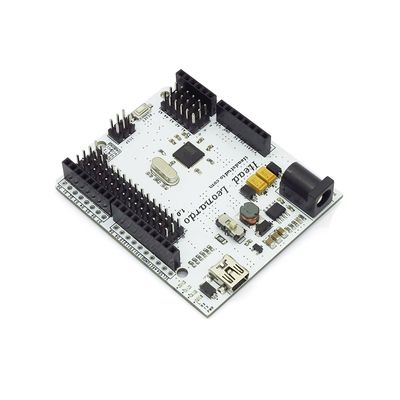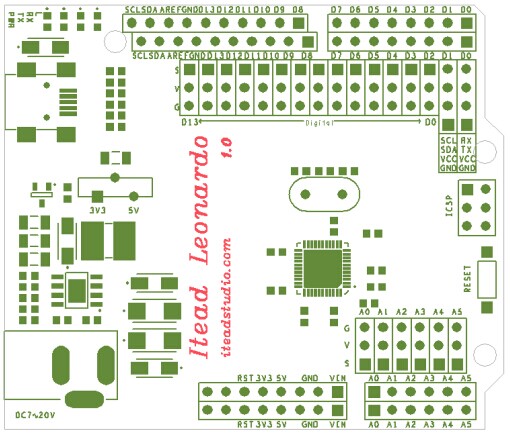Difference between revisions of "Iteaduino Leonardo"
(→Memory) |
(→Input and Output) |
||
| Line 134: | Line 134: | ||
==Input and Output== | ==Input and Output== | ||
| + | Each of the 20 digital i/o pins on the Uno can be used as an input or output, using pinMode(), digitalWrite(), anddigitalRead() functions. They operate at 5 volts. Each pin can provide or receive a maximum of 40 mA and has an internal pull-up | ||
| + | resistor (disconnected by default) of 20-50 kOhms. In addition, some pins have specialized functions: | ||
| + | |||
| + | * '''Serial: 0 (RX) and 1 (TX).''' Used to receive (RX) and transmit (TX) TTL serial data using the ATmega32U4hardware serial capability. Note that on the Leonardo, the '''Serial''' class refers to USB (CDC) communication; for TTL serial on pins 0 and 1, use the '''Serial1''' class. | ||
| + | * '''TWI: 2 (SDA) and 3 (SCL).''' Support TWI communication using the [http://arduino.cc/en/Reference/Wire Wire library]. | ||
| + | * '''External Interrupts: 2 and 3.''' These pins can be configured to trigger an interrupt on a low value, a rising or falling edge, or a change in value. See | ||
| + | the attachInterrupt() function for details. | ||
| + | * '''PWM: 3, 5, 6, 9, 10, 11, and 13.''' Provide 8-bit PWM output with the analogWrite() function. | ||
| + | * '''SPI: on the ICSP header.''' These pins support SPI communication using the SPI library. Note that the SPI pins are not connected to any of the digital I/O pins as they are on the Uno, They are only available on the ICSP connector. This means that if you have a [[shield]] that uses SPI, but does NOT have a 6-pin ICSP connector that connects to the Leonardo's 6-pin ICSP header, the [[shield]] will not work. | ||
| + | * '''LED: 13.''' There is a built-in LED connected to digital pin 13. When the pin is HIGH value, the LED is on, when the pin is LOW, it's off. | ||
| + | * '''Analog Inputs: A0-A5, A6 - A11 (on digital pins 4, 6, 8, 9, 10, and 12).''' The Leonardo has 12 analog inputs, labeled A0 through A11, all of which can also be used as digital i/o. Pins A0-A5 appear in the same locations as on the Uno; inputs A6-A11 are on digital i/o pins 4, 6, 8, 9, 10, and 12 respectively. Each analog input provides 10 bits of resolution (i.e. 1024 different values). By default the analog inputs measure from ground to 5 volts, though is it possible to change the upper end of their range using the AREF pin and the analogReference() function. | ||
| + | |||
| + | There are a couple of other pins on the board: | ||
| + | * '''AREF.''' Reference voltage for the analog inputs. Used with analogReference(). | ||
| + | * '''Reset.''' Bring this line LOW to reset the microcontroller. Typically used to add a reset button to shields which block the one on the board. | ||
==Communication== | ==Communication== | ||
Revision as of 07:38, 20 May 2014
Contents
Overview
Iteaduino Leonardo is a microcontroller board based on the ATmega32u4, it's 100% campatible with Arduino Leonardo. It has 20 digital input/output pins, a 16 MHz crystal oscillator, a micro USB connection, a power jack, an ICSP header, and a reset button. It contains everything needed to support the microcontroller; simply connect it to a computer with a USB cable or power it with an AC-to-DC adapter or battery to get started.
Iteaduino Leonardo differs from all preceding boards in that the ATmega32u4 has built-in USB communication, eliminating the need for a secondary processor. This allows the Leonardo to appear to a connected computer as a mouse and keyboard, in addition to a virtual (CDC) serial / COM port. It also has other implications for the behavior of the board.
Features
- Efficient DC-DC Power supply with wide range input.
- 3.3V/5V Operating Voltage selection
- All pins out for Sensor and Servo
- UART/IIC interface breakout
- All electronic brick socket are broken out
Spec
| Microprocessor | ATmega32U4 |
| PCB Size | 68.58mm X 58.42mm X 1.6mm |
| Indicators | Power,TX,RX,L |
| Power supply(recommended) | 7-23V DC |
| Power supply(limits) | 23 VDC(max) |
| Communication Protocol | UART,SPI,IIC |
| Clock Speed | 16MHz |
| RoHS | Yes |
Electrical Characteristics
| Specification | Min | Type | Max | Unit |
| Input voltage | 7 | - | 23 | VDC |
| Operating Voltage | - | 3.3/5 | - | VDC |
| DC Current per I/O Pin | - | 40 | - | mA |
Hardware
Digital/Servo Interface: D0~D13 pin
Sensor Interface: A0 A1 A2 A3 A4 A5 pin
Pin Map
| Index | Name of Arduino | Alternate Function | Pin of Atmega32u4 |
| 1 | D0 | UART DIN | PD2 |
| 2 | D1 | UART DOUT | PD3 |
| 3 | D2 | IIC_SDA | PD1 |
| 4 | D3 | IIC_SCL/PWM | PD0 |
| 5 | D4 | External Interrupt 0/A6 | PD4 |
| 6 | D5 | External Interrupt 1/PWM | PC5 |
| 7 | D6 | PWM | PD7 |
| 8 | D7 | A7 | PE6 |
| 9 | D8 | A8 | PB4 |
| 10 | D9 | PWM/A9 | PB5 |
| 11 | D10 | PWM/A10 | PB6 |
| 12 | D11 | PWM | PB7 |
| 13 | D12 | A11 | PD6 |
| 14 | D13 | PWM | PC7 |
| 15 | A0 | PF7 | |
| 16 | A1 | PF6 | |
| 17 | A2 | PF5 | |
| 18 | A3 | PF4 | |
| 19 | A4 | PF1 | |
| 20 | A5 | PF0 |
Power Supply
The Arduino Leonardo can be powered via the micro USB connection or with an external power supply. The power source is selected automatically.
External (non-USB) power can come either from an AC-to-DC adapter (wall-wart) or battery. The adapter can be connected by plugging a 2.1mm center-positive plug into the board's power jack. Leads from a battery can be inserted in the Gnd and Vin pin headers of the POWER connector.
The board can operate on an external supply of 7 to 23 volts. If supplied with less than 7V, however, the 5V pin may supply less than five volts and the board may be unstable.
The power pins are as follows:
- VIN. The input voltage to the Iteaduino board when it's using an external power source (as opposed to 5 volts from the USB connection or other regulated power source). You can supply voltage through this pin, or, if supplying voltage via the power jack, access it through this pin.
- 5V. The regulated power supply used to power the microcontroller and other components on the board. This can come either from VIN via an on-board regulator, or be supplied by USB or another regulated 5V supply.
- 3V3. A 3.3 volt supply generated by the on-board regulator. Maximum current draw is 250 mA.
- GND. Ground pins.
- IOREF. The voltage at which the i/o pins of the board are operating (i.e. VCC for the board). This is 5V on the Iteaduino Leonardo.
Memory
The ATmega32u4 has 32 KB (with 4 KB used for the bootloader). It also has 2.5 KB of SRAM and 1 KB of EEPROM (which can be read and written with the EEPROM library).
Input and Output
Each of the 20 digital i/o pins on the Uno can be used as an input or output, using pinMode(), digitalWrite(), anddigitalRead() functions. They operate at 5 volts. Each pin can provide or receive a maximum of 40 mA and has an internal pull-up resistor (disconnected by default) of 20-50 kOhms. In addition, some pins have specialized functions:
- Serial: 0 (RX) and 1 (TX). Used to receive (RX) and transmit (TX) TTL serial data using the ATmega32U4hardware serial capability. Note that on the Leonardo, the Serial class refers to USB (CDC) communication; for TTL serial on pins 0 and 1, use the Serial1 class.
- TWI: 2 (SDA) and 3 (SCL). Support TWI communication using the Wire library.
- External Interrupts: 2 and 3. These pins can be configured to trigger an interrupt on a low value, a rising or falling edge, or a change in value. See
the attachInterrupt() function for details.
- PWM: 3, 5, 6, 9, 10, 11, and 13. Provide 8-bit PWM output with the analogWrite() function.
- SPI: on the ICSP header. These pins support SPI communication using the SPI library. Note that the SPI pins are not connected to any of the digital I/O pins as they are on the Uno, They are only available on the ICSP connector. This means that if you have a shield that uses SPI, but does NOT have a 6-pin ICSP connector that connects to the Leonardo's 6-pin ICSP header, the shield will not work.
- LED: 13. There is a built-in LED connected to digital pin 13. When the pin is HIGH value, the LED is on, when the pin is LOW, it's off.
- Analog Inputs: A0-A5, A6 - A11 (on digital pins 4, 6, 8, 9, 10, and 12). The Leonardo has 12 analog inputs, labeled A0 through A11, all of which can also be used as digital i/o. Pins A0-A5 appear in the same locations as on the Uno; inputs A6-A11 are on digital i/o pins 4, 6, 8, 9, 10, and 12 respectively. Each analog input provides 10 bits of resolution (i.e. 1024 different values). By default the analog inputs measure from ground to 5 volts, though is it possible to change the upper end of their range using the AREF pin and the analogReference() function.
There are a couple of other pins on the board:
- AREF. Reference voltage for the analog inputs. Used with analogReference().
- Reset. Bring this line LOW to reset the microcontroller. Typically used to add a reset button to shields which block the one on the board.
Communication
Programming
Automatic (Software) Reset and Bootloader
Initiation
USB Over-current Protection
Physical Characteristics
Download
Datasheet for Iteaduino Leonardo
Schematic for Iteaduino Leonardo
Fritzing Parts for Iteaduino Leonardo
 Notice
Notice
